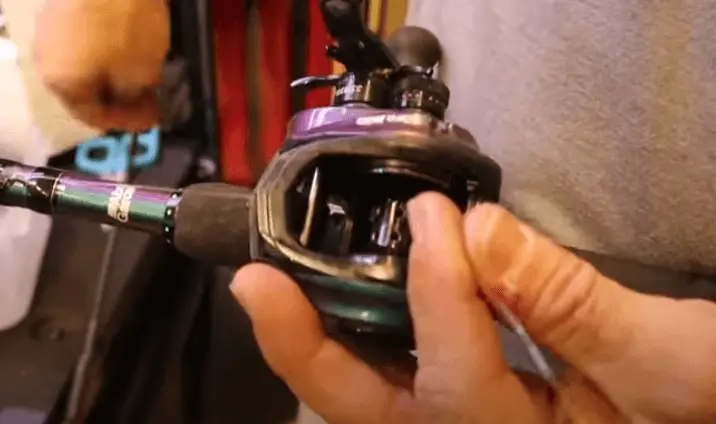To spool a baitcaster, attach the line to the reel and wind evenly across the spool. Maintain light tension for a tight, orderly line lay, let’s go for full guide –
Baitcasting reels are essential tools for anglers aiming to cast with success and control. Spooling your baitcaster correctly is critical to prevent line twists and bird’s nests during casting. Experienced fishermen know that a well-spooled baitcaster can make a significant difference between a frustrating day on the water and a successful fishing trip.
The process involves threading the line through the rod guides, securing it to the reel spool, and winding it in a consistent manner while keeping tension. Understanding the nuances of your specific reel is also key, as each model may have slightly different requirements for optimal performance. Today, we’ll explore the essential steps on how to spool a baitcaster for beginners to advance guide for properly spool a baitcaster.
Types Of Baitcasting Reels
Understanding the Types of Baitcasting Reels is important for any angler looking to gain success and control in their fishing technique. Baitcasters come in various forms, each tailored to specific fishing requirements and personal preferences. Let’s take a closer look at the two primary styles you’ll encounter: round and low-profile baitcasters.
Choosing The Right Baitcaster for Spool
Finding the perfect baitcaster is important for a successful fishing trip. A baitcaster well-matched to your fishing style increases casting accuracy and overall ease of use. Choose wisely to make every cast count.
Essential Spooling Supplies
Before you begin spooling your baitcaster, gather all the necessary supplies. Doing so ensures a flawless and efficient process. This section outlines the essential items you’ll need to start spooling like a pro.
Selecting The Proper Fishing Line
The first step is to choose the right fishing line. The type of line you select can greatly impact your casting and fish-catching experience. Consider the weight and strength of the line based on the species of fish you’re targeting.
- Monofilament is a versatile, affordable choice suitable for beginners.
- Fluorocarbon offers near invisibility underwater, ideal for clear-water fishing.
- Braided line boasts high durability and strength, perfect for larger fish.
Tools Needed For A Smooth Spooling Process
Proper tools make spooling simple and efficient. Ensure you have the following on hand:
- A baitcasting reel secured to a fishing rod.
- A spool-tensioning tool or pencil to maintain even pressure on the line.
- Scissors or clippers for trimming excess line.
- A clean cloth to wipe down and hold the line as you spool.
With these supplies, your baitcaster will be ready to fish in no time. Remember to spool slowly to avoid line twists and ensure optimal performance on the water.
Preparing The Baitcaster For Spooling
Spooling a baitcaster is key to fishing success. A correctly spooled baitcaster casts further and reduces line tangling. Before starting, ensure the baitcaster is prepared correctly. This guide focuses on the essential prep steps for spooling a baitcaster.
Securing The Reel To The Rod
First, attach the reel to the fishing rod. It’s a must for stable spooling. Here is a step-by-step approach:
- Open the reel seat on the rod.
- Place the reel foot into the seat.
- Tighten until the reel is firm and does not wiggle.
Make sure the reel aligns with the rod guides. Alignment is important for smooth casting.
Adjusting Tension And Brake Systems
Proper adjustments prevent line issues. Baitcasters have tension knobs and brake systems to configure.
- Find the tension knob, usually next to the reel handle.
- Turn it slightly, while holding the rod horizontally.
- If equipped, adjust the brake system according to the manual.
Adjustments will vary depending on the reel model. Referring to the owner’s manual is wise for model-specific settings.
How To Spool a Baitcaster : Spooling Guide
Welcome to the Step-by-Step Spooling Guide tailored for the eager anglers looking to become expert at setting up their baitcaster. Mastering the spooling of a baitcaster can transform your fishing experience, leading to more accurate casts and fewer line tangles. Follow these important steps to ensure your line is spooled correctly and you’re ready for a day out on the water.
Threading The Line Through Guides
Start by opening the bail on your reel to free the line. Hold your rod at the handle and thread the line starting from the rod tip. Guide the line through each eyelet, moving towards the reel. Keep the line centered to avoid snags and ensure smooth casting later on. Once reached, flip the bail back to its original position to secure the line.
Tying The Line To The Spool
With the line through the guides, it’s time to attach it to your baitcaster spool. Use an arbor knot, which is reliable and easy to tie:
- Wrap the line around the spool.
- Tie a simple overhand knot around the standing line.
- Tie a second overhand knot at the end of the tag line.
- Pull on the standing line to tighten the first knot against the spool.
- Trim any excess from the tag end after the knots are secure.
Maintaining Tension And Winding Properly
Proper tension is critical to avoid line twists and ensure a smooth cast. Follow these steps to wind correctly:
- Hold the line between your fingers to maintain tension.
- Turn the reel handle slowly, so the line wraps evenly.
- Fill the spool until there’s a 1/8 inch gap from the rim.
Check for even distribution across the spool while winding. If you notice any bumps or uneven areas, stop and adjust the line before proceeding. A well-spooled baitcaster can be the difference between a frustrating day and a successful fishing trip.
Common Spooling Mistakes To Avoid
Those new to baitcasting often make simple mistakes when spooling their reels. When the line isn’t spooled correctly, it can lead to frustration on the water. Let’s tackle some common mistakes to ensure a smooth and efficient casting experience.
Overfilling The Spool
A fully loaded spool can cause tangles and reduce casting accuracy. To keep casts smooth and prevent overrun, fill the spool until it’s about 1/16 inches from the rim. This optimal level ensures enough line for long casts while minimizing backlash risks.
Twists And Loops In The Line
Line twists lead to knots and impair performance. To avoid this, ensure the line comes off the filler spool the same way it goes onto the baitcaster. Line spooled against its natural curl creates troublesome loops.
Inadequate Tension During Spooling
Consistent tension is key for a well-spooled reel. Without it, the line will lay loosely and lead to ‘dig-ins’ during a forceful cast. Use a spooling station or have a friend apply gentle pressure to maintain even tension as you wind the line.
Testing And Tuning Post-spooling
After spooling your baitcaster, it’s essential to test and tune it for peak performance. This process includes fine-tuning the drag system and practicing casting techniques with the newly spooled line. The right settings and skills make a world of difference on the water. Begin with the drag system, the line’s first line of defense against a fighting fish. Mastering casting techniques with your fresh line helps avoid tangles and backlashes.
Fine-tuning The Drag System
Adjusting the drag on your baitcaster is important . A properly set drag prevents line breaks during a catch. Follow these simple steps:
- Turn the drag knob to tighten or loosen.
- Check resistance by pulling the line.
- Look for a smooth release without line breakage.
A well-adjusted drag offers a balance of control and protection. It safeguards the line while putting pressure on fish.
How To Spool a Baitcaster For Beginners
Proper casting with a new line minimizes tangles and improves accuracy. Emphasize these points:
- Practice short casts to get a feel for the line.
- Focus on thumb control to manage line flow.
- Gradually increase casting distance as you gain confidence.
Experiment with different weights and lures. Consistent practice enhances muscle memory and technique, resulting in fewer backlashes and more enjoyable fishing trips with your baitcaster.
Frequently Asked Questions For How To Spool A Baitcaster
What Is The Proper Way To Spool A Baitcaster?
Spooling a baitcaster properly involves attaching the line to the reel, maintaining tension, and winding evenly. Start by threading the line through the rod guides. Secure it to the spool with an arbor knot. Hold the line taut with your fingers and reel slowly, ensuring the line lays flat without loops or twists.
Can You Overfill A Baitcaster Spool?
Yes, overfilling a baitcaster spool can cause problems like backlash and line tangles. Aim to fill the spool to about 1/8 inch from the top. This optimizes casting performance and reduces the risk of line management issues, ensuring a smoother fishing experience.
Conclusion
Mastering the art of spooling a baitcaster can elevate your fishing experience significantly. By employing the steps outlined, you’ll enjoy smoother casting and fewer tangles. Embrace patience as you practice, and soon enough, the process will feel like second nature.
Happy fishing and tight lines!


